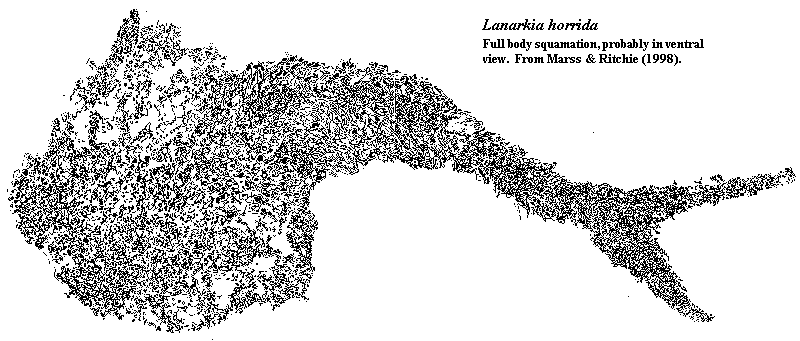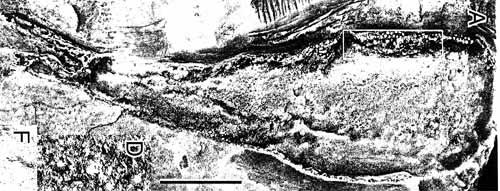
| Palaeos: |  |
Thelodonti |
| The Vertebrates | Overview |
| Page Back | Unit Home | Unit Dendrogram | Unit References | Taxon Index | Page Next |
| Unit Back | Vertebrates Home | Vertebrate Dendrograms | Vertebrate References | Glossary | Unit Next |
|
Abbreviated Dendrogram
Vertebrata |--Conodonta `--+--Pteraspidomorphi `--Thelodonti |--+--Furcacaudiformes | `--Thelodontida `--+--+--Katoporida | `--Cephalaspidomorphi | |--Galeaspida | `--+--Pituriaspida | |--Osteostraci | `--Gnathostomata (conventional placement) `--+--Loganiidae `--Gnathostomata (alternate placement) |--Placodermi `--+--Chondrichthyes `--Teleostomi |
Contents
Overview |
Among Vertebrata, the Thelodonti are the drifters and vagabonds of Paleozoic phylospace -- a diverse, poorly known group of jawless fish of no fixed address on the phylogenetic tree, without established family or visible means of support. Their only common trait -- one cannot really call it a synapomorphy -- is that they are entirely covered in small (1mm or less in length), thick scales, vaguely similar to the scales of early gnathostomes. In many cases, the scales did not forms lines or patterns as in most other microsquamose (small-scaled) fish, but were arranged randomly, giving them an almost furry appearance in some reconstructions. Their body form is Protean. Take a line drawing of almost any reasonably known Paleozoic fish. Erase the internal lines. Fill in the diagram with tiny half-ellipses representing scales. Chances are that the resulting picture will resemble some known family of thelodonts. Phillipe Janvier's Tree of Life page on the Thelodonti shows some examples. Note that one looks generally like a deep-bodied gnathostome, another like a galeaspid, yet another (Lanarkia, the one on the left), like nothing in particular.
So, why have we chosen this riff-raff as the namesake of a large clade of vertebrates? Like conodonts, the thelodonts were generally ignored in polite society for many years. Unlike conodonts, we have not benefited from any sudden enlightenment about their true nature as vertebrates. However, for more than a decade, researchers have suggested that the group may be paraphyletic. This now seems like a sensible working assumption. It is not entirely sensible to assume that their resemblance to all the other jawless fishes is merely coincidental. Based largely on Wilson & Caldwell (1998) and Donoghue et al. (2000), we have taken the plunge here and treated Thelodonti as a huge clade uniting the classical thelodonts with all other recognizably fishy vertebrates other than pteraspidomorphs. For our purposes, we define the Thelodonti, tentatively, as the stem group consisting of all vertebrates having a more recent common ancestor with Salmo than with Psammolepis.
Previously, "Myopterygia" had an almost equivalent spot on the cladogram. However, Myopterygia was defined by Janvier in terms of physical characters, rather than ancestry, which is risky. In fact, the taxon has more recently been disowned by its creator. We, too, have come to the reluctant conclusion that paired lateral fins, the most obvious synapomorphy of Myopterygia, are not at all unique and have been independently derived in at least three taxa, if they are not a plesiomorphic feature of Craniata. Some of the reasons for this conclusion are discussed in connection with Ateleaspis and in our introduction to the Vertebrates.
As awkward as this arrangement may seem, our arrangement permits the monophyly of the headshield forms, for whom we have recycled the name Cephalaspidomorphi -- galeaspids, pituriaspids and osteostracans. It also allows Loganellia, a conventional thelodont, to lie closer to the gnathostomes than any of the cephalaspidomorphs. At the same time, other thelodonts resemble heterostracans in, for example, the structure of the tail. It would not be surprising to learn, in another few years, that there are "thelodont" pteraspidomorphs as well, and that what we are calling "Thelodonti" today should be redefined to include all vertebrates other than conodonts, anaspids and hagfishes.
However, we add an important caveat. While it may be didactically useful and instructive to adopt the specific phylogeny described in this section, this phylogeny has no more scientific validity than one of those Victorian portrayals of the Scala Naturae: with nasty, brutish labyrinthodonts at the shadowed base, looking up with resentful loathing at the craggy features of some bearded European academician standing in the noble light of Pure Reason at the very apex of Creation. In fact, all "thelodont" groups -- including the one with craggy labyrinthodonts and nasty academicians -- are vertebrates incertae sedis. At the present time, there are no reliable phylogenies. The arrangement in this Section is simply one -- not even the most likely one -- of many possible arrangements; and there are no immediate prospects for a closer approach to the True Tree. In fact, one of our secret agents, inserted deep within the thelodont research community, informs us that we are possibly even headed in reverse. That is, the main pillars on which thelodont taxonomy has been constructed (chiefly scale histology) are in the process of being deconstructed, leading us yet further into squalid ignorance, if that's possible. Some of the first moves in this game are in some of the materials below. ATW030621.

Few scientists are courageous enough to speculate in public about the origin of thelodonts. The first undoubted thelodont scales come from early in the Late Ordovician, the Sandbian Age. However, few would be surprised to find an Early Ordovician, or even Furongian, thelodont. These oldest known Ordovician scales are notably simpler in morphology and ornamentation than the scales found in Silurian or Devonian strata [S+96] [S+01]. However, other Ordovician thelodonts, only slightly younger, look much more like "normal" thelodonts, except for an unusually thick base of bone [So+01]. The oldest known scales resembling scales from gnathostomes are essentially contemporaneous with these earliest thelodont remains. So, all things considered, stratigraphy doesn't help much in sorting out thelodont origins and relationships.
 One
suspects that thelodonts may have been, originally, extremely basic
creatures. Take even a simple craniate, on the order of Pikaia
perhaps, begin adding a few scales, and it begins to look like a basic
thelodont. That isn't quite fair, since all known whole-body thelodonts
are roughly fish-shaped at least. However, Archipelepis,
probably the earliest thelodont known from a whole body fossil [S+01], has only
eyes, possibly a line of primitive gill orifices, a very simple caudal fin and
no other identifiable features.
One
suspects that thelodonts may have been, originally, extremely basic
creatures. Take even a simple craniate, on the order of Pikaia
perhaps, begin adding a few scales, and it begins to look like a basic
thelodont. That isn't quite fair, since all known whole-body thelodonts
are roughly fish-shaped at least. However, Archipelepis,
probably the earliest thelodont known from a whole body fossil [S+01], has only
eyes, possibly a line of primitive gill orifices, a very simple caudal fin and
no other identifiable features.
References: (Sansom et al 1996) [S+96], (Sansom et al 2001) [S+01], Soehn et al. (2001) [So+01].
| Page Back | Unit Home | Glossary | Page Top | Page Next |
checked ATW040827